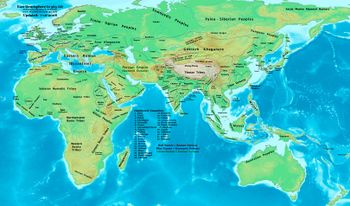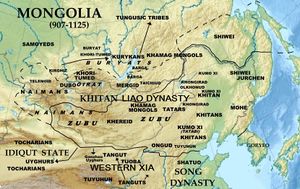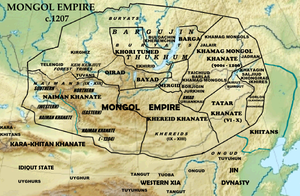تويوهون
تويوهون | |||||||
|---|---|---|---|---|---|---|---|
| 284–670 | |||||||
 آسيا عام 565م، ويظهر على الخريطة تويوهون والمناطق المجاورة لها. | |||||||
| المكانة | مملكة | ||||||
| العاصمة | فوتشي | ||||||
| الحكومة | ملكية | ||||||
| خاقان | |||||||
• 284-317 | مورونگ تويوهون | ||||||
• 635-672 | مورونگ نويهبو | ||||||
| الحقبة التاريخية | العصر الحديدي | ||||||
• تأسست | 284 | ||||||
• تابعة لصين تانگ | 634 | ||||||
• دمرتها الامبراطورية التبتية | 670 | ||||||
| |||||||
تويوهون (الصينية: 吐谷渾[1]؛ بالتبتية: ‘A-zha؛ بالتوركية: توقون)، كانت مملكة قوية أسسها البدو الأوراسيون كانت مرتبطة بشيانبـِيْ في جبال تشيليان وأعالي وادي النهر الأصفر، في چينگهاي الحالية، بالصين.[2]
التاريخ
After the disintegration of the Xianbei state, nomadic groups were led by their khagan, Tuyuhun, to the rich pasture lands around Qinghai Lake about the middle of the 3rd century AD.
Murong Tuyuhun (慕容吐谷渾) was the older brother of the Former Yan's ancestor Murong Hui[3] and elder son of the Chanyu Murong Shegui (慕容涉歸) of the Murong Xianbei who took his people from their original settlements on the Liaodong Peninsula to the region of the Yin Mountains, crossing the Yellow River between 307 and 313, and into the eastern region of modern Qinghai.[4]
The Tuyuhun Empire was established in 284[5] by subjugating the native peoples referred to as the Qiang, including more than 100 different and loosely coordinated tribes that did not submit to each other or any authority.
After Tuyuhun died in Linxia, Gansu in 317, his sixty sons further expanded the empire by defeating the Western Qin (385-430) and Xia (407-431) kingdoms. The Qinghai Xianbei, Tufa Xianbei, Qifu Xianbei and Haolian Xianbei joined them. They moved their capital 6 كيلومتر (3.7 mi) west of Qinghai Lake.[6]
These Xianbei groups formed the core of the Tuyuhun Empire and numbered about 3.3 million at their peak. They carried out extensive military expeditions westward, reaching as far as Hotan in Xinjiang and the borders of Kashmir and Afghanistan, and established a vast empire that encompassed Qinghai, Gansu, Ningxia, northern Sichuan, eastern Shaanxi, southern Xinjiang, and most of Tibet, stretching 1,500 kilometers from east to west and 1,000 kilometers from north to south. They unified parts of Inner Asia for the first time in history, developed the southern route of the Silk Road, and promoted cultural exchange between the eastern and western territories, dominating the northwest for more than three and half centuries until it was destroyed by the Tibetan Empire.[7] The Tuyuhun Empire existed as an independent kingdom outside China[8] and was not included as part of Chinese historiography.
النزاع بين امبراطوريتي تانگ والتبت

الانحلال
اللغة
Alexander Vovin (2015) identifies the extinct Tuyuhun language as a Para-Mongolic language, meaning that Tuyuhun is related to Mongolic as a sister clade but is not directly descended from the Proto-Mongolic language.[9] The Khitan language is also a Para-Mongolic language.
الثقافة
The Tuyuhun people were experts in horse breeding and also practised agriculture. As a realm just between the Chinese empires in the east (Northern Wei, and the Southern Dynasties) and other steppe tribes such as the Rouran Khaganate and the Tiele people, the Tuyuhun acted as envoys and traders, while many Buddhist missionaries and travelers crossed their country.[بحاجة لمصدر]
When the Chinese pilgrim monk, Songyun, visited the region in 518, he noted that the people had a written language, which was more than a hundred years before Thonmi Sambhota is said to have returned from India after developing a script for writing the Tibetan language.[10]
الحكام
| الاسماء الملكية | أسماء العائلة والاسم الممنوح | فترة الحكم |
|---|---|---|
| Henan King (河南王) | 慕容吐谷渾 مورنگ تويوهون | 284-317 |
| Henan King (河南王) | 慕容吐延 Mùróng Tǔyán | 317-329 |
| Tuyuhun King (吐谷渾王) | 慕容葉延 Mùróng Yèyán | 329-351 |
| Tuyuhun King (吐谷渾王) | 慕容碎奚 Mùróng Suìxī | 351-371 |
| Bailan King (白蘭王) | 慕容視連 Mùróng Shìlián | 371-390 |
| Tuyuhun King (吐谷渾王) | 慕容視羆 Mùróng Shìpí | 390-400 |
| دا تشانيو (大單于) | 慕容烏紇褆 Mùróng Wūgētí | 400-405 |
| Wuyin Khan (戊寅可汗)/ دا تشانيو (大單于)/ Wu King (武王) |
慕容樹洛干 Mùróng Shùluògān | 405-417 |
| Bailan King (白蘭王) | 慕容阿柴 Mùróng Āchái | 417-424 |
| Hui King (惠王)/ King of Longxi (隴西王) |
慕容慕璝 Mùróng Mùguī | 424-436 |
| Henan King (河南王) | 慕容慕利延 Mùróng Mùlìyán | 436-452 |
| Henan King (河南王)/ Xiping King (西平王) |
慕容拾寅 Mùróng Shíyín | 452-481 |
| Henan King (河南王) | 慕容度易侯 Mùróng Dùyìhóu | 481-490 |
| 慕容伏連籌 Mùróng Fúliánchóu | 490-540 | |
| خان | 慕容夸呂 Mùróng Kuālǔ | 540-591 |
| خان | 慕容世伏 Mùróng Shìfú | 591-597 |
| بوسابو خان (步薩鉢可汗) | 慕容伏允 مورنگ فويون | 597-635 |
| Zhugulüwugandou Khan (趉故呂烏甘豆可汗)/ Daning King (大寧王)/ Xiping Commandery King (西平郡王) |
慕容順 Mùróng Shùn | 635 |
| Wudiyebaledou Khan (烏地也拔勒豆可汗)/ Heyuan Commandery King (河源郡王) |
慕容諾曷鉢 Mùróng Nuòhébō | 635-672 |
شجرة العائلة الحاكمة
| شجرة عائلة حكام تويوهون | |||||||||||||||||||||||||||||||||||||||||||||||||||||||||||||||||||||||||||||||||||||||||||||||||||||||||||||||||||||||||||||||||||||||||||||||||||||||||||||||||||||||||||||||||||||||||||||||||||||||||||||||||||||||||||||||||||||||||||||||||||||||||||||||||||||||||||||||||||||||||||||||||||||||||||||||||||||||||||||||||||||||||||||||||||||||||||||||||||||||||||||||||||||||||||||||||||||||||||||||||||||||||||||||||||||||||||||||||||||||||||||||||||||||||||||||||||||||||||||||||||||||||||||||||||||||||||||||||||||||||||||||||||||||||||||||||||||||||||||||||||||||||||||||||||||||||||||||||||||||||||||||||||||||||||||||||||||||||||||||||||||||||||||||||||||||||||||||||||||||||||||||||||||||||||||||||||||||||||||||||||||||||||||||||||||||||||||||||||||||||||||||||||||||||||||||||||||||||||||||||||||||||||||||||||||||||||||||||||||||||||||||||||||||||||||||||||||||||||||||||||||||||||||||||||||||||||||||||||||||||||||||||||||||||||||||||||||||||||||||||||||||||||||||||||||||||||||||||||||||
|---|---|---|---|---|---|---|---|---|---|---|---|---|---|---|---|---|---|---|---|---|---|---|---|---|---|---|---|---|---|---|---|---|---|---|---|---|---|---|---|---|---|---|---|---|---|---|---|---|---|---|---|---|---|---|---|---|---|---|---|---|---|---|---|---|---|---|---|---|---|---|---|---|---|---|---|---|---|---|---|---|---|---|---|---|---|---|---|---|---|---|---|---|---|---|---|---|---|---|---|---|---|---|---|---|---|---|---|---|---|---|---|---|---|---|---|---|---|---|---|---|---|---|---|---|---|---|---|---|---|---|---|---|---|---|---|---|---|---|---|---|---|---|---|---|---|---|---|---|---|---|---|---|---|---|---|---|---|---|---|---|---|---|---|---|---|---|---|---|---|---|---|---|---|---|---|---|---|---|---|---|---|---|---|---|---|---|---|---|---|---|---|---|---|---|---|---|---|---|---|---|---|---|---|---|---|---|---|---|---|---|---|---|---|---|---|---|---|---|---|---|---|---|---|---|---|---|---|---|---|---|---|---|---|---|---|---|---|---|---|---|---|---|---|---|---|---|---|---|---|---|---|---|---|---|---|---|---|---|---|---|---|---|---|---|---|---|---|---|---|---|---|---|---|---|---|---|---|---|---|---|---|---|---|---|---|---|---|---|---|---|---|---|---|---|---|---|---|---|---|---|---|---|---|---|---|---|---|---|---|---|---|---|---|---|---|---|---|---|---|---|---|---|---|---|---|---|---|---|---|---|---|---|---|---|---|---|---|---|---|---|---|---|---|---|---|---|---|---|---|---|---|---|---|---|---|---|---|---|---|---|---|---|---|---|---|---|---|---|---|---|---|---|---|---|---|---|---|---|---|---|---|---|---|---|---|---|---|---|---|---|---|---|---|---|---|---|---|---|---|---|---|---|---|---|---|---|---|---|---|---|---|---|---|---|---|---|---|---|---|---|---|---|---|---|---|---|---|---|---|---|---|---|---|---|---|---|---|---|---|---|---|---|---|---|---|---|---|---|---|---|---|---|---|---|---|---|---|---|---|---|---|---|---|---|---|---|---|---|---|---|---|---|---|---|---|---|---|---|---|---|---|---|---|---|---|---|---|---|---|---|---|---|---|---|---|---|---|---|---|---|---|---|---|---|---|---|---|---|---|---|---|---|---|---|---|---|---|---|---|---|---|---|---|---|---|---|---|---|---|---|---|---|---|---|---|---|---|---|---|---|---|---|---|---|---|---|---|---|---|---|---|---|---|---|---|---|---|---|---|---|---|---|---|---|---|---|---|---|---|---|---|---|---|---|---|---|---|---|---|---|---|---|---|---|---|---|---|---|---|---|---|---|---|---|---|---|---|---|---|---|---|---|---|---|---|---|---|---|---|---|---|---|---|---|---|---|---|---|---|---|---|---|---|---|---|---|---|---|---|---|---|---|---|---|---|---|---|---|---|---|---|---|---|---|---|---|---|---|---|---|---|---|---|---|---|---|---|---|---|---|---|---|---|---|---|---|---|---|---|---|---|---|---|---|---|---|---|---|---|---|---|---|---|---|---|---|---|---|---|---|---|---|---|---|---|---|---|---|---|---|---|---|---|---|---|---|---|---|---|---|---|---|---|---|---|---|---|---|---|---|---|---|---|---|---|---|---|---|---|---|---|---|---|---|---|---|---|---|---|---|---|---|---|---|---|---|---|---|---|---|---|---|---|---|---|---|---|---|---|---|---|---|---|---|---|---|---|---|---|---|---|---|---|---|---|---|---|---|---|---|---|---|---|---|---|---|---|---|---|---|---|---|---|---|---|---|---|---|---|---|---|---|---|---|---|---|---|---|---|---|---|---|---|---|---|---|---|---|---|---|---|---|---|---|---|---|---|---|---|---|---|---|---|---|---|---|---|---|---|---|---|---|---|---|---|---|---|---|---|---|---|---|---|---|---|---|---|---|---|---|---|---|---|---|---|---|---|---|---|---|---|---|---|---|---|---|---|---|---|---|---|---|---|---|---|---|---|---|---|---|---|---|---|---|---|---|---|---|---|---|---|---|---|---|---|---|---|---|---|---|---|---|---|---|---|---|---|---|---|---|---|---|---|---|---|---|---|---|---|---|---|---|---|---|---|---|---|---|---|---|---|---|---|---|---|---|---|---|---|---|---|---|---|---|---|---|---|---|---|---|---|---|---|---|---|---|---|---|---|---|---|---|---|---|---|---|---|---|---|---|---|---|---|---|---|---|---|---|---|---|---|---|---|---|---|---|---|---|---|
| |||||||||||||||||||||||||||||||||||||||||||||||||||||||||||||||||||||||||||||||||||||||||||||||||||||||||||||||||||||||||||||||||||||||||||||||||||||||||||||||||||||||||||||||||||||||||||||||||||||||||||||||||||||||||||||||||||||||||||||||||||||||||||||||||||||||||||||||||||||||||||||||||||||||||||||||||||||||||||||||||||||||||||||||||||||||||||||||||||||||||||||||||||||||||||||||||||||||||||||||||||||||||||||||||||||||||||||||||||||||||||||||||||||||||||||||||||||||||||||||||||||||||||||||||||||||||||||||||||||||||||||||||||||||||||||||||||||||||||||||||||||||||||||||||||||||||||||||||||||||||||||||||||||||||||||||||||||||||||||||||||||||||||||||||||||||||||||||||||||||||||||||||||||||||||||||||||||||||||||||||||||||||||||||||||||||||||||||||||||||||||||||||||||||||||||||||||||||||||||||||||||||||||||||||||||||||||||||||||||||||||||||||||||||||||||||||||||||||||||||||||||||||||||||||||||||||||||||||||||||||||||||||||||||||||||||||||||||||||||||||||||||||||||||||||||||||||||||||||||||
انظر أيضاً
- تسونگخا
- قائمة دول العصر البرونزي
- قائمة دول العصر الكلاسيكي
- قائمة دول العصر الحديدي
- قائمة القوى العظمى في العصور الوسطى
المصادر
- ^ Beckwith 1993, p. 17.
- ^ Frederick W. Mote (2003). Imperial China 900-1800. p. 170.
- ^ Zizhi Tongjian, vol. 90.
- ^ The T'u-yü-hun from the Northern Wei to the time of the Five Dynasties, p. XII. 1970. Gabriella Molè. Rome. Is.M.E.O.
- ^ 281 is the foundation for the first or 'Former' (of the four) Murong Xianbei Kingdoms. See Charles Holcombe, The Genesis of East Asia, 221 B.C.-A.D. 907: 221 B.C.-A.D.907,University of Hawaii Press, 2001 pp.130-131.
- ^ "Note sur les T’ou-yu-houen et les Sou-p’i." Paul Pelliot. T’oung pao, 20 (1921), p. 323.
- ^ Zhou, Weizhou [周伟洲] (1985). The Tuyühu History [《吐谷浑史》] . Yinchuan [银川]: Ningxia People's Press [宁夏人民出版社].
- ^ Beckwith 2009, p. 128-129.
- ^ Vovin, Alexander. 2015. Some notes on the Tuyuhun (吐谷渾) language: in the footsteps of Paul Pelliot. In Journal of Sino-Western Communications, Volume 7, Issue 2 (December 2015).
- ^ Ancient Tibet: Research Materials from the Yeshe De Project (1986), p. 136. Dharma Publishing, California. ISBN 0-89800-146-3.
أعمال مرجعية
- Beckwith, Christopher I. (2009). Empires of the Silk Road: A History of Central Eurasia from the Bronze Age to the Present. Princeton University Press. ISBN 0-691-13589-4.
{{cite book}}: Invalid|ref=harv(help) - Beckwith, Christopher I. (1993). The Tibetan Empire in Central Asia: A History of the Struggle for Great Power Among Tibetans, Turks, Arabs, and Chinese During the Early Middle Ages. Princeton University Press. ISBN 0-691-02469-3.
{{cite book}}: Invalid|ref=harv(help)
وصلات خارجية
- Emperor Taizong's campaign against Tuyuhun - with the 634 defeat of Tuyuhun troops
- http://www.chinaknowledge.de/History/Altera/tuyuhun.html



